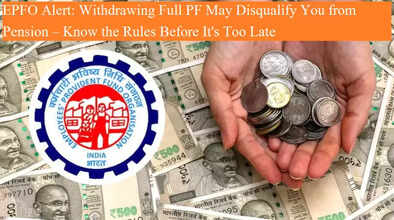EPFO Alert: Withdrawing Full PF May Disqualify You from Pension – Know the Rules Before It's Too Late

Your PF Is Not Just Savings — It’s the Gateway to Your Pension
If you're a salaried employee in India, a portion of your salary is deducted every month as Provident Fund (PF), which is managed by the Employees' Provident Fund Organisation (EPFO). While most people consider PF merely as a savings scheme, it also lays the foundation for your pension after retirement. However, to avail pension benefits, there are specific rules you must follow—especially regarding the EPS (Employees’ Pension Scheme) portion. Withdrawing the entire PF amount, including the pension component, can disqualify you from receiving a monthly pension in the future.
💰 How Much of Your Salary Goes Into PF?
Each month, 12% of your basic salary is contributed to your PF account. Your employer matches this contribution with another 12%. However, it’s important to understand how the employer’s share is divided:
-
8.33% goes into EPS (Pension Scheme)
-
3.67% goes into your EPF (Provident Fund) account
🛑 Why You May Not Get a Pension
Many employees, after switching jobs or retiring, tend to withdraw their entire PF balance, including the EPS portion. Here’s the catch: If you withdraw the EPS amount, you lose your eligibility for pension under the EPFO scheme.
To be eligible for a pension:
-
You must have contributed to the EPF for at least 10 years
-
You should not withdraw your EPS fund during this period
If you’ve met these conditions and are 50 years or older, you become eligible to claim a pension.
✔️ Keep Your EPS Fund Intact
The most important rule is: Do not withdraw from the EPS fund if you want a pension later in life. Even if you withdraw from the PF account for financial emergencies, leave your EPS fund untouched. Keeping your EPS active ensures that you can claim pension benefits once you reach the eligible age.
🕒 When Can You Claim Your Pension?
As per EPFO regulations:
-
If you’ve contributed to EPF for 10 years or more
-
And you’ve kept your EPS fund intact
-
You can start receiving pension from age 50 onwards
This pension provides a steady income after retirement and acts as a long-term financial cushion.
🆕 New Pension Withdrawal Rules from January 2025
To make pension access easier, EPFO has introduced a new facility effective from January 1, 2025:
-
Pensioners can now receive their pension through any bank, not just through a pre-designated one
-
The digital verification process has made claiming pensions quicker and more convenient
-
This is especially helpful for retired employees who have moved to different towns or rural areas
🔍 Key Takeaways for Employees:
-
Your PF account is more than a savings tool—it’s also your pension lifeline
-
Avoid withdrawing the EPS component if you want monthly pension after retirement
-
Maintain contributions for at least 10 years to become pension-eligible
-
Use the latest digital facilities introduced by EPFO for smoother pension withdrawals
🔚 Final Thoughts
Retirement planning doesn’t end with savings—it begins with smart financial decisions during your working years. If you withdraw your entire PF including the EPS, you may unknowingly sacrifice a regular pension in the future. Understand the rules, make informed decisions, and ensure that your golden years remain financially secure.SEO Keywords:

